DACF Home → Bureaus & Programs → Maine Natural Areas Program → Communities, Plants, and Animals → Invasive Plants → Multiflora Rose
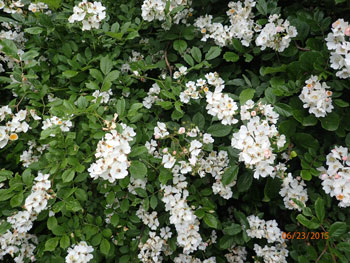 Multiflora rose flowers
Multiflora rose flowers
Multiflora Rose
(Rambler rose)
Rosa multiflora
2019 Status in Maine: Widespread. Very Invasive.
Description: Perennial, deciduous shrub, up to 20' tall, usually very branched, with arching canes that can grow up other plants into low tree branches. Canes have stout, recurved thorns. Thornless varieties exist, but they are uncommon. Leaves: Pinnately compound, 5-11 leaflets, each ~1" long, with teeth. Petiole is fringed at the base (stipule) where it attaches to twig; no other rose in Maine has this character. Flowers: 5-parted, white to pale pink, ~1" wide, clustered at twig tips, blooms in June in Maine. Fruit: ~¼" round to oblong, red, rose "hips" clustered at twig tips.
Native range: Japan and Asia. How arrived in U.S.: Rootstock for ornamental roses; also promoted for erosion control and living fences.
Reproduction: By seed and rooting from twig tips. Birds and mammals eat fruits and disperse seed. Seeds viable in soil for up to 20 years.
Habitat: Reaches largest size and fruiting capacity in full sun but is somewhat shade-tolerant. Found in forest edges, old fields, as well as disturbed sites. Can occur in forest interior after disturbance such as timber harvest. Tolerant of dry to moist soils.
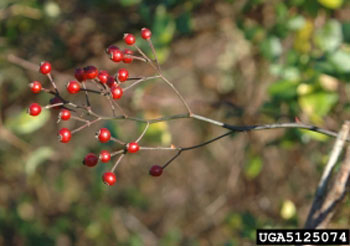 Multiflora rose hips. Chris Evans, University of Illinois, Bugwood.org
Multiflora rose hips. Chris Evans, University of Illinois, Bugwood.org
Similar native species: Native roses, but none of our native roses have a fringed base on the leaf petiole. Also, all native roses have pink flowers.
Similar non-native species: Rugosa rose (Rosa rugosa) has pink flowers to 2" wide and stems with prickles all around. Other horticultural roses escape infrequently and have fewer flowers, as well as other prickle arrangements.
Fact Sheets and Identification Links
- Vermont Fact Sheet and Species Highlight for Multiflora Rose
- Herndon Environmental Network, Virginia, Identification Video (5:30)
- Eno River Citizen Science, North Carolina, Identification Video (1:53)
- Go Botany page for Rosa multiflora
Control Methods
Small plants and seedlings may be pulled up by the roots when soil is moist (wear gloves!); larger plants can be cut, but re-sprouting will occur.* Persistent cutting or mowing multiple times during the growing season over several years may kill the plant, but diligence is required. Mowing can prevent seedlings from establishing. Goats will browse it but repeated, heavy damage over multiple years is required to kill established shrubs. Herbicides† are effective as foliar applications (glyphosate or triclopyr solution), cut-stump application (glyphosate or triclopyr solution applied immediately after cutting except in early spring), or basal bark application (glyphosate or triclopyr ester in bark oil).
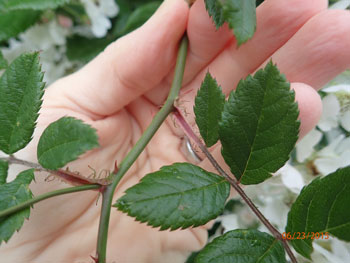 Multiflora rose leaf stipules
Multiflora rose leaf stipules
Control Technique Video Demonstrations
- Herndon Environmental Network, Virginia (5:30), hand tools, disposal, herbicides, biological control, native alternatives.
Please email invasives.mnap@maine.gov if you have questions about invasive species in Maine
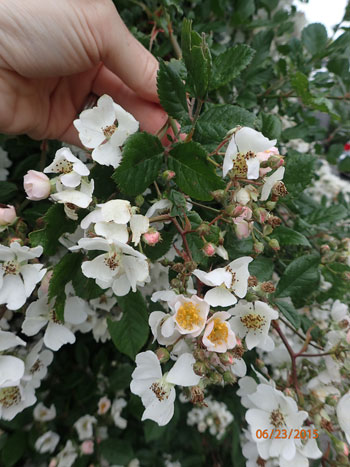 Multiflora rose flowers
Multiflora rose flowers
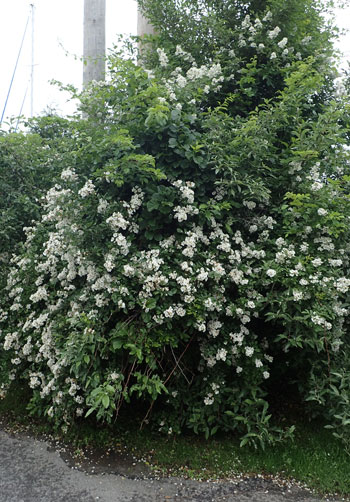 Multiflora rose habit
Multiflora rose habit